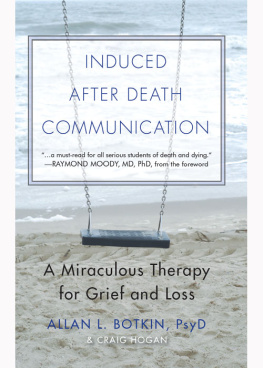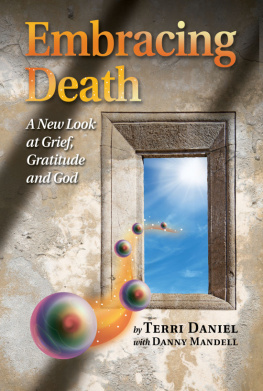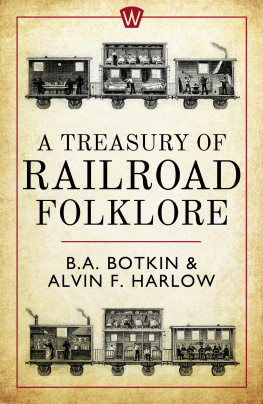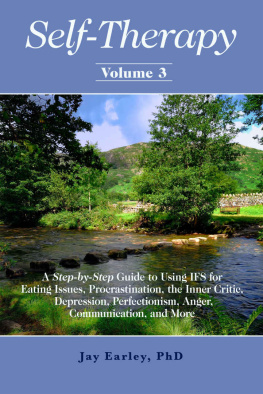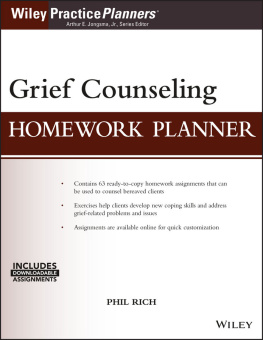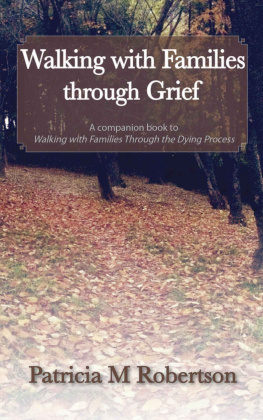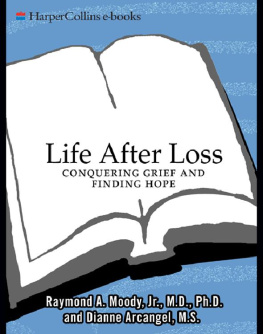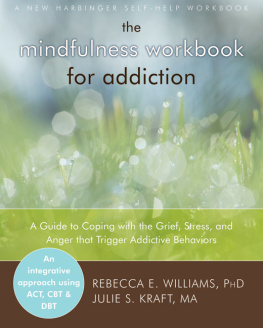The truth is, once I began reading this manuscript I could not put the book down! It is my view that Dr. Allan Botkin has made a major breakthrough in the treatment of those suffering from the emotional consequences of loss and grief.
The Rev. Dr. Ralph S. Leonard, Vice President Emeritus for Church Relations, Carthage College, Kenosha, Wisconsin
Dr. Botkin has hit upon a fascinating and powerful new tool that may not only help his clients cope with their losses, but also breaks new ground in understanding life and death.
Bruce Greyson, M.D., Professor of Psychiatric Medicine, University of Virginia, School of Medicine; Editor, Journal of Near-Death Studies
There have been very few major breakthroughs in the field of psychology in the last hundred years, and Dr. Allan Botkin has certainly achieved one of them. His discovery has implications that go well beyond clinical practice.
Alan L. Strand, Ph.D., psychologist
Induced After-Death Communication: A New Therapy for Healing Grief and Trauma is an authentic and believable story of Dr. Botkin's groundbreaking discovery of a new and very powerful treatment for grief. But even more than that, the book provides readers with a whole new way of thinking about and experiencing our relationships and our lives. The book offers hope and comfort, and a new kind of peace of mind.
The book is written in a compelling style that makes it difficult to put down and leaves you hungry for more. This is not only a book for psychologists and psychotherapists, but for all people who seek to understand the meaning of life, and death.
Linda Harper, Ph.D., psychologist, author

Copyright 2005, 2014
by Allan L. Botkin, Psy.D., with R. Craig Hogan, Ph.D.
All rights reserved. No part of this publication may be reproduced or transmitted in any form or by any means, electronic or mechanical, including photocopying, recording, or by any information storage and retrieval system, without permission in writing from Hampton Roads Publishing, Inc. Reviewers may quote brief passages. Originally published in 2005 by Hampton Roads Publishing Company, Inc., ISBN: 1-57174-423-1.
Cover design by Jim Warner
Cover photograph shutterstock / Kati Neudert
Interior designed by Deborah Dutton
Hampton Roads Publishing Company, Inc.
Charlottesville, VA 22906
Distributed by Red Wheel/Weiser, LLC
www.redwheelweiser.com
Sign up for our newsletter and special offers by going to
www.redwheelweiser.com/newsletter/.
ISBN: 978-1-57174-712-9
Library of Congress Cataloging-in-Publication Data available upon request.
Printed in the United States of America.
EBM
10 9 8 7 6 5 4 3 2 1
www.redwheelweiser.com
www.redwheelweiser.com/newsletter
CONTENTS
ACKNOWLEDGMENTS
First and foremost, I am forever indebted to the combat veterans I worked with as a psychologist for over twenty years in a Veterans Administration (VA) hospital. They served in WWII, Korea, Vietnam, Desert Storm, and a variety of other dangerous situations. I learned to admire and respect these veterans, not only for their courage in combat, but also for their courage in confronting their deepest pain in therapy. The discovery presented in this book was shared in the most intimate way with these veterans. At times we cried, and at other times we laughed until it hurt. We hugged often. I miss those guys. Since retiring from the VA, I go back and visit them from time to time. We were, and still are, like family.
This book would not have been possible if it weren't for those pioneers who laid the foundation for the ideas it contains. Although I never met Dr. Elisabeth Kbler-Ross (she passed away in 2004), she did more than any other human being to establish death and dying as legitimate professional and scientific subjects. I also express my deeply held appreciation for Dr. Francine Shapiro, who provided us with the most powerful psychological technique ever known to alleviate human suffering.
In my journey, I have been honored to receive encouragement and support from a few of my heroes and leaders in the field: Dr. Raymond Moody, Dr. Bruce Greyson, and Bill Guggenheim. Each is well known worldwide, and each has made significant contributions to the field either of near-death experiences or after-death communications. Although I have had the opportunity to meet and discuss my findings with Raymond and Bill, I have yet to meet in person Dr. Greyson, who consistently stepped in by phone and mail to provide timely professional support when I desperately needed it. Thank you, Dr. Greyson.
You would not be reading this book right now if Frank DeMarco, the cofounder and editor in chief of Hampton Roads Publishing Company, did not save this manuscript, at the last minute, from going into the trash bin. Getting published has been a long, and at times, very frustrating endeavor. More than anything, I want Frank, at some point, to feel that he made the right decision in backing this work.
As a psychologist, I never envisioned myself writing a book for the general public. Although I had published a few scientific papers, I realized that my writing skills were very limited and that I couldn't do it on my own. I needed a good professional writer, preferably one who had a personal and intellectual appreciation for this discovery. Finding the right writer has also not been easy. Induced After-Death Communication began to take on its current form only after Dr. Craig Hogan stepped in and helped me turn this discovery into a readable book.
I want to offer a special thanks to Professor Ralph Leonard, a remarkable individual with extensive academic training and experience in theology and grief counseling, for his ongoing and enthusiastic support of this work.
From time to time, I think about colleagues who provided support and encouragement along the way. I want to express my gratitude to Karen Paddock, Dr. Sheilah Perrin, Greg Rimoldi, Dr. David Mannelli, Dr. Kathy Parker, Dr. Merle Moffat, Dr. John Schaut, Dr. Howard Lipke, Dr. Ivan Aubuchon, Dr. Mitch Goodman, Dr. Stacey Jones, Dr. Kimberly Kroll, Dr. JoAnn Nishimoto, Dr. Alan Strand, Dr. Carol Paxton-Cox, Dr. Iris Newman, Dr. Illene Berns-Zare, Dr. Cory Habben, Dr. Samantha Shelton, Dr. Suzi Francis Thornton, Dr. Susan Bowen, Dr. Nicole Bodor, Dr. Linda Harper, and Dr. Darcy Mouton.
Along the way, I chanced upon loyal supporters who always seemed to be there when I needed them for help in promoting this discovery. I want to give a heartfelt thanks to Diane Willis, coordinator of the Chicago International Association for Near-Death Studies (IANDS), and to Bobby, a loyal supporter who has done much to get this information out to the public. I would be remiss if I did not mention a good friend and movie producer, Patrick Wells, whose contagious enthusiasm has done much to promote the IADC discovery.
Last, and certainly not least, I thank my family for being there for me all along, and especially during the last few years of risk and uncertainty in my endeavor. My parents, Edith and Leroy Botkin, never let up on their abundance of unconditional love and support. All my love to Barbara, Allie, and Max, who, more than anyone else, had to put up with me during this book-writing phasethanks for loving me back.
FOREWORD
Life after death is not yet a scientific issue, but experiences suggestive of an afterlife have been an important clinical issue for some time. It is well known, for example, that patients who are resuscitated after close calls with death often have inspiring tales of afterlife adventures to tell. So, doctors involved in the care of these patients need to be able to listen empathetically. The survivors of close calls need to be reassured that they are not alone and that several medical studies show that an appreciable percentage of those who return from death's door tell of leaving their bodies and entering into a bright, comforting light of love. These patients also tell of reunions with loved ones lost to death during these life-changing interludes.
Next page
